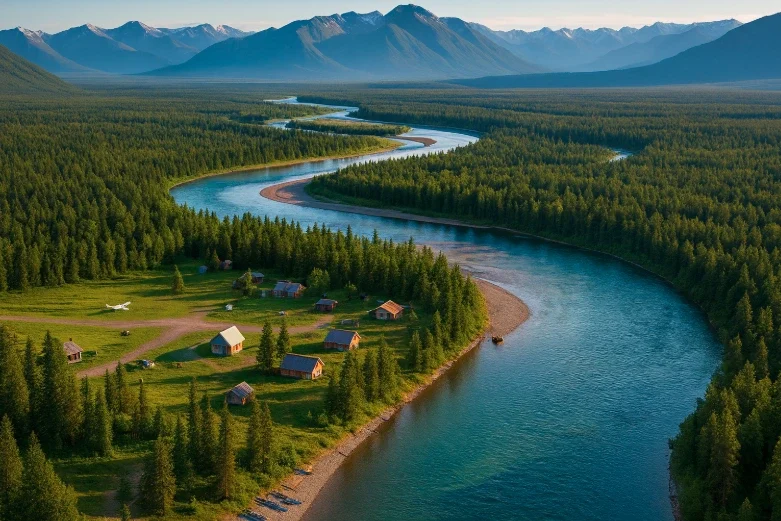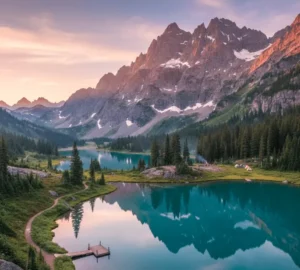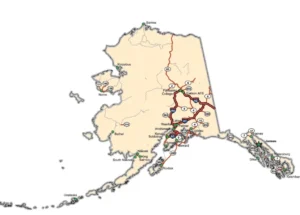If you’ve ever traveled through Interior Alaska, you know some places feel different the moment you step into them.
Alatna is one of those places.
Here, you don’t just see Athabascan traditions, you feel them in the rhythm of daily life. You hear them in the way elders talk about the river, you taste them in the salmon smoked at summer camps, and you see them in the quiet pride of families who still live the way their grandparents taught them.
When you stand on the banks of the Koyukuk and watch the river moving past, you start to understand why people here say the land teaches you how to live. And when you talk to anyone from Alatna, you quickly realize something important:
This community hasn’t just preserved its culture; it has also fostered it. It’s living it every day.
Quick Facts About Alatna (So You Know Where You’re Standing)
| Category | Information |
| Location | Yukon–Koyukuk Census Area, Unorganized Borough, Alaska |
| Coordinates | 66.54889° N, 152.84472° W |
| Region | Upper Koyukuk River (north bank) |
| Nearby Community | Allakaket (immediately to the east) |
| Distance From Fairbanks | ~190 air miles (306 km) NW |
| Distance From Hughes | ~57 miles (92 km) upriver |
| Total Area | 36.5 sq mi (94.5 km²), all land |
| Elevation | Avg: 640 ft (195 m) • Min: 381 ft (116 m) • Max: 1,365 ft (416 m) |
| Population (2025 est.) | 45 residents |
| Population Growth | Up from 15 residents in 2020 (+50% increase) |
| Annual Growth Rate | 7.14% annually |
| Population Density | 0.41 people per sq mi |
| Median Age | 43.6 years |
| Male Median Age | 66.4 years |
| Female Median Age | 43.1 years |
| Racial Composition | 100% Native American (predominantly Koyukon Athabascan) |
| Average Household Income | $56,688 |
| Per Capita Income | $33,750 |
| Poverty Rate | 4.55% |
| Climate Type | Cold Continental (Interior Alaska) |
| Avg. July High | 70°F (21°C) |
| Avg. January Low | -31°F (-35°C) |
| Temperature Range | High: 94°F (34°C) • Low: -75°F (-59°C) |
| Annual Precipitation | 13 in (33 cm) |
| Annual Snowfall | 72 in (183 cm) |
| River Ice-Free Period | June through October |
| ZIP Code | 99720 |
| Area Code | 907 |
| FIPS Code | 02-01305 |
| Time Zone | AKST (UTC -9) • AKDT (UTC -8, DST) |
How the Koyukuk River Shapes Athabascan Culture in the Koyukuk Valley
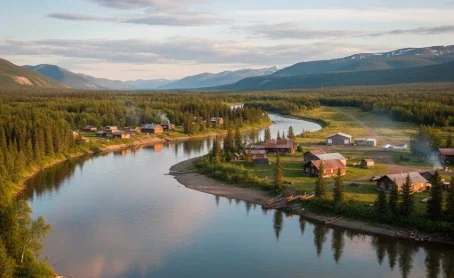
The Koyukuk River plays a central role in Koyukuk River cultural heritage. If you spend time in Alatna, you’ll notice how families read the river’s ice, flow, and seasonal changes. These observations form part of the Athabascan culture in Alaska, where land-based knowledge is essential.
The river serves as:
- A travel route
- A food source
- A connection between neighboring villages
- A record of environmental changes
These factors support the continuity of Native culture, Alaska tribes, and village traditions across the Koyukuk Valley.
Also Read: A Journey Through Bethel, Alaska’s Rich Cultural Heritage and Traditions
Athabascan Culture in Alatna Values You See Every Day

Athabascan culture isn’t something people explain with long definitions.
You see it in simple, everyday moments.
You’ll notice how people treat elders
They’re not just respected, they’re the living libraries of the community. When elders speak, people listen. And if you spend time in a home here, you’ll hear stories about tracking moose, preparing hides, or reading changing weather patterns.
You’ll notice how people treat animals
Hunting is done with gratitude, not excitement. Nothing is wasted. Every part has a purpose. This isn’t a hobby, it’s a relationship with the land.
You’ll notice how people treat each other
If someone catches a moose, the whole village benefits. Food is shared. Families look after one another. This is the heart of Alaska Native village traditions, and Alatna keeps that spirit strong.
Storytelling, Language, and Cultural Identity in the Koyukuk Region
If you sit with an elder in Alatna, you won’t just hear stories, you’ll feel history moving through their voice.
Stories teach you:
- How to respect the river
- Why certain animals behave the way they do
- How people survived harsh winters
- And how families stayed strong even in the hardest times
A real moment you might see in Alatna
You might find a grandmother cutting fish at camp, speaking in soft Koyukon Athabascan.
A grandchild watches her hands, small, steady movements that have been repeated for generations.
You’ll hear the child repeat a word or two back to her.
And just like that, a language stays alive.
It’s not a classroom.
It’s life.
And that’s how culture survives here.
Also Read: Life in Alakanuk, Alaska: Balancing Yup’ik Traditions and Modern Living (2025)
Seasonal Subsistence and Alatna Ancestral Practices
Seasonal life patterns form the foundation of Alatna’s ancestral practices. The shift from summer to fall or winter to spring guides the activities you see across the community.
Summer: Fish Camps and River Work
Fish camps remain one of the strongest expressions of Athabascan culture in Alaska. You see smokehouses working, children helping prepare salmon, and families organizing food for winter.
Fall: Moose and Caribou Season
Moose provides essential meat, hide, and tools. Fall hunting demonstrates cultural responsibility and skill, supporting the Athabascan lifestyle and heritage.
Winter: Trail Travel and Indoor Cultural Activities
Winter brings sewing, carving, language use, and extended storytelling. Snowmachine trails connect Alatna to nearby communities, keeping traditional travel routes active.
Spring: Breakup and Seasonal Preparation
Breakup signals the transition toward open water, prompting households to prepare equipment for summer subsistence work.
Key Cultural Practices in Alatna
| Practice | When It Occurs | Cultural Role |
| Salmon fishing & drying | Summer | Supports food security and cultural identity |
| Moose hunting | Fall | Reinforces land knowledge and respectful harvest practices |
| Berry & plant gathering | Late summer | Supports traditional medicine and community sharing |
| Beadwork & sewing | Year-round | Preserves artistic forms of Native culture |
| Winter trail travel | Winter | Maintains traditional navigation and village connectivity |
These activities are consistently referenced in regional assessments of heritage preservation in Interior Alaska.
Also Read: Alaska Native Traditions Through Oral History
How Alatna Maintains Cultural Continuity in a Changing Environment
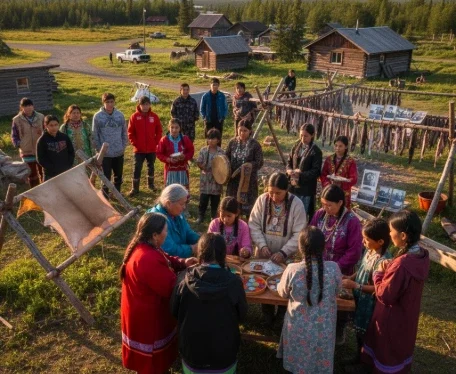
Daily life in rural Alaska presents several challenges, including erosion, high transportation costs, and shifts in climate conditions. Yet Alatna continues to maintain strong patterns of Alatna Native community life.
Community Gatherings
Potlucks, seasonal events, and cooperative work reinforce community culture.
Intergenerational Learning
Children learn through participation, not formal classes. This supports the natural transmission of Native customs and strengthens cultural continuity.
Regional Cultural Support
Partnerships with organizations in Interior Alaska contribute to documentation, language support, and youth programs, aiding long-term heritage preservation.
How Alatna Keeps Culture Alive Even When the World Is Changing
If you talk to people in Alatna, they’ll tell you straight:
Life is not easy here.
Travel is expensive.
Riverbanks erode.
Climate changes make ice conditions unpredictable.
Jobs are limited.
But culture isn’t disappearing because people refuse to let it.
Community gatherings keep people connected
Potlucks, dances, and holiday events keep families united.
Children learn culture by doing
There are no “culture classes.”
Kids learn by being part of everything: fish cutting, hunting, sewing, cooking, traveling the trails.
Regional organizations support the effort
Language, youth programs, and elder knowledge groups across Interior Alaska help strengthen what Alatna already does naturally.
Culture survives because everyone participates.
Also Read: Before You Visit Akiachak, Alaska: 7 Surprising Facts You Must Know
FAQs
1. What language do people in Alatna speak?
Most residents speak English, but many elders understand and use Koyukon Athabascan. Regional programs support language preservation.
2. How do people in Alatna travel between villages?
Travel is seasonal:
- Boats in summer
- Snowmachines in winter
- Small aircraft year-round
3. What foods are traditionally harvested in the Koyukuk River area?
Moose, salmon, whitefish, caribou, berries, and seasonal plants remain important subsistence foods.
4. What challenges does Alatna face today?
Erosion, rising travel costs, climate impacts, and limited services are common issues in remote Alaska communities.
5. How is Athabascan culture taught to children?
Children learn through participation in subsistence activities, listening to elders, observing traditional practices, and helping with seasonal tasks.






